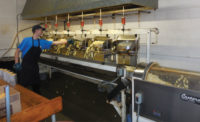

Founders Mary and Vincent Sconza (and Jim Sconza’s parents) started the business in 1939 in their Oakland kitchen making peanut brittle. They eventually moved into an industrial location and gradually expanded into hard and panned confections.
“We only had a few pieces of equipment and about 15 to 20 employees in 1967,” he says. Moving was a relatively simple process, Sconza adds.
Fast forward almost 40 years and the situation had dramatically changed. WhenCandy Industryvisited the facility in late 2004, the company had 80 employees, was operating 120 coating pans in four different panning rooms, and had an offsite warehouse. Describing operating conditions as “cramped” was being kind.
Thanks to Sconza and his dedicated staff, which included key family members, the company’s reputation for high-quality, value-priced products, be they sugar- , dextrose- , chocolate- or yogurt-coated items, had spurred growth. Over the last four years, the company has enjoyed 15% annual sales gains.
“We were encountering space and efficiency problems,” Sconza explains. Ron Sconza, Jim’s son and v.p.-operations, provides a tell-tale example of how crowded the situation had become.
“I had four people in Oakland dedicated to just moving candy and pallets around just so we could operate,” he says. It was obvious that to continue on a double-digit growth path, the company had to find a larger facility.
Conscious of the need to find an appropriate site, Jim, Ron and other members of the management team, began their search. It proved to be an exhausting and time-consuming endeavor, with consideration given to moving the operation outside of the United States as well as along the West Coast.

Technical services analyst Cathryn Inez prepares caramelized coconut cashews with Jesse Hodges, quality system supervisor, looking on in the company’s 1,600-sq.-ft. R&D facility.
Twice, the company had placed options on a piece of land before pulling out at the last minute, Ron recalls. The first time involved a site in British Columbia, which stemmed from Ron meeting up with an economic developer from that province at a Pack Expo show.
“My father, however, was having a tough time with moving to Canada,” he says. “He pointed out that he was an American and wanted the company to remain in the United States. We already had the plans for a new facility readied for the site, but walked away.”
The search then resumed along the West Coast, with a site in Medford, Ore., surfacing as a serious contender. Again, with some minor modifications to the building plans in order to accommodate the new site, the company was close to “pulling the trigger.”
“I had just come back from my vacation when my father called me on the weekend, saying the Hershey facility in Oakdale was up for sale. And I thought, ‘Here we go again,’” Ron says.
It didn’t take long for father and son to view the facility, nor to make a decision.

Such decisiveness stemmed, in part, not only from having spent hours upon hours visiting locations, but from understanding what the company needed to operate efficiently. In having an engineering firm design a “greenfield” facility for Sconza, it was obvious to Jim and Ron the cost savings of occupying an existing confectionery facility.
“We knew what a ‘free’ infrastructure was going to be worth to us,” Ron points out. “Because the engineering firm had done a complete operational survey on us, we had the cost data on sugar silos, boilers and other infrastructure needs. It’s important to note that despite the building’s age – it opened in 1965 – Hershey had kept it in tip-top shape
"Hershey had built such a first-class structure and had maintained it so well, it was ideal for us,” adds Jim.
And despite competing with other bidders for the building, the company had an advantage; Hershey liked the idea of another confectionery company coming in and taking over the site.
“Hershey pulled out the stops for Sconza,” Ron emphasizes. “They were concerned about the new owners being good for its employees, good for the community.”
Within 90 days of visiting the facility, the Sconza Candy Co. had a deal. Hershey continued operating the plant until January 30, 2008, and then began removing its equipment during the ensuing months.
“We also purchased the sugar and corn syrup silos from them as well as the conveying system they had in the plant,” Jim notes.
On May 1, 2008, contractors for Sconza Candy Co. moved in immediately after the deal closed and began installing air conditioning, humidifier and warm air systems, as well as electrical, water and steam piping.
Thanks to the engineering work done previously, the Sconza Candy Co. virtually “dropped the building” into the Hershey facility, Ron explains. That building included eight panning rooms that would ensure complete environmental control over temperature and humidity.

Production supervisor Warren Sanchez inspects a handful of dark chocolate almonds being panned by operator Roger Alcala.
During the time construction proceeded at the Hershey facility, Sconza Candy Co.’s management team worked furiously to ensure the transition from Oakland to Oakdale would proceed smoothly.
“It was a logistical challenge,” admits Jim. “We had eight to 10 people working on planning the move. Actually, the move wasn’t really difficult, the planning, however, was.”
But as Ron details, the company took advantage of past industry experience from colleagues in helping deal with the move.
“We had lots of conversations with people who had done this before, such as Jim Hanlon [formerly with Harmony Foods] and our friends at Jelly Belly,” he says. “They gave us plenty of advice. We covered our bases as well as we could.”
In the interim, the company focused on notifying its customers as well as building up inventory to ensure a seamless shift from Oakland to Oakdale, a 100-mile shuffle.
As son-in-law Greg Cater, v.p. – marketing and sales, points out, some of the company’s key customers admitted to being “nervous,” but were willing to cooperate in providing advance projections in order for Sconza Candy Co. to build up inventory.
“We took a proactive stance about the move, pointing out how it would help our operations,” he adds.
Thanks to all the upfront planning, it took only a week before most lines were operational after the company shut its doors on November 14 in Oakland and held the ribbon-cutting ceremony in Oakdale on November 17.
“One of our biggest concerns involved moving our equipment [150 trucks were required for equipment, furniture, inventoryand supplies], but our crew nailed it,” Ron says. We were only 5% off of where we expected our inventories to be in the changeover.”

Workers load one of 18 pans in one of two panning rooms dedicated to chocolate. Insulated wall panels featuring foam core-metal walls ensure efficient automatic control of temperature and humidity levels.
That doesn’t mean, however, that the company is done with taking advantage of its new facility, Jim and Ron assert.
“We’re looking at putting in an enrobing line within the next two years,” Ron says. The company has sold a variety of enrobed products and it’s time to introduce that capability in-house. “We’re at a volume that makes this an easy decision,” he adds.
In addition to adding some vertical form/fill/seal packaging machines, the company is entertaining thoughts about installing other company production lines in the facility.
“We’re looking at contract manufacturing customers that have indicated a desire to possibly locate their equipment in our facility, particularly since we now have the ability [and room] to accommodate them,” Cater says.
Indeed, the company’s capacities and capabilities have changed dramatically.
“We can grow our business 30%, maybe more, with the same exact equipment we have,” he points out. That hasn’t been lost on several of its long-time as well as potentially new customers.
“We’ve received several inquiries from larger national manufacturers who are looking for cost-effective, domestic producers,” Cater says. It also allowed the company to embrace some long-standing projects that simply couldn’t be handled because of space and efficiency constraints.
“At the Winter Fancy Food Show we introduced candy-coated chocolate Sunflower Seeds under theSunlights name,” he adds. “There were several requests from customers asking us to include such an item in our product line.”

Workers hand pack finished products coming off a CMD vertical form/fill/seal unit that uses an Ishida scaler.
“Customers simply want to buy such an item from us,” he says. “We were the only remaining domestic jawbreaker manufacturer not offering it in our lineup.”
Last year, the company did a “soft launch” involving two nonmeltable items designed for summer sales: caramelized mixed nuts and cinnamon vanilla almonds.
“We have had no shortage of ideas,” Cater points out. Prior to the move, however, the R&D department was shoehorned in 400 sq. ft. of space. Today, it occupies 1,600 sq. ft.
In addition, with the construction of the eight segregated panning rooms as well as the availability to have isolated nut roasting, nut storage and finished product areas, allergen tracking and containment has greatly improved.
“One of the best features of being in this facility is that we can now zone for allergens,” Ron says. “It was difficult to do that in Oakland.”
And as Cater notes, “The chances of product contamination occurring because of an allergen are eliminated.”
The eight panning rooms, which hold 18 pans each, are also all interconnected with PLC control panels that precisely handle air temperatures, humidity, spraying volume, air application, even the burning off of alcohol from confectioner’s glaze.
“It gives us the ability to control exactly the center to coating ratio,” explains Ron. “It ensures even batching on each pan. Our managers, operators love it.”
Another benefit that the move delivered for Sconza involves proximity to key ingredients, such as nuts. Located in the heart of almond country near Modesto, Calif., the Oakdale site also is close to various tree nut, raisin and other dried fruit suppliers. In fact, Blue Diamond Growers recently purchased from Hershey a 132,000-sq.-ft. cold storage building on property that adjoins the Sconza Candy Co. plant.
Currently, the company’s product mix breaks out almost evenly between “hard” (sugar and dextrose-coated) products and “soft” or chocolate and yogurt-coated items. About 25% of the company’s sales involved branded items, with private label/contracting manufacturing projects accounting for 40% of revenues and “Sconza bulk” representing the remaining 35%.
“The largest increases in sales to date have come from private label/contract manufacturing,” Cater says. “Of course, that can be a more volatile business. Our aim is to continue to build theSconza brand in several areas.”

Cater, however, views sales within the private label/contract manufacturing sector as an extension of the“Sconza brand” since it embodies the company’s reputation within the confectionery industry.
“We reproduce premium items in a more value-based format,” he says. It’s a formula that’s earned the company kudos in the past, and one that portends well for it in the future.
As Janet Sconza Angers, v.p. of customer relations and Jim’s daughter, notes, “The company has been around for many years.” During that time, it’s built up a loyal group of customers that range in size from multinationals to mom-and-pops, she says.
“It’s more of a technological age today, so our customers expect a rapid response,” Angers adds. As contract manufacturing sales increase, commensurate with all the more stringent demands associated with larger clients, so does the level of quality and service, she points out.

Plant engineer Nick Barretto (right) and Ron Sconza, v.p. – manufacturing, monitor panning operations via the PLC control panel, which is in every panning room. The interconnected panels enable managers and operators to precisely control temperature, humidity and coating volume.
“That’s typical of Jim’s hands-on approach,” Cater says. “He’s very much engaged in the business. People ask me if he works half days, and yes, I tell them he does – 12-hour half days.
“It’s been Jim’s dream for 40 years to grow his family business,” he says. This year, Sconza Candy Co. will celebrate 70 years of growth going back to the time his father founded the business in 1939. The company plans to hold a 70th anniversary celebration sometime this spring.
“We’ve been focused on getting the plant running,” Jim says. Nevertheless, customers and suppliers will get a chance to see up close and personal “Sconza’s new house,” a facility that has set the foundation for continued growth for the third and fourth generations.
“It will be a celebration for Jim as much on an emotional level as it will be on a business/financial level,” Cater adds.
Indeed, it’s a celebration that the entire confectionery industry can toast with a heartfelt “Salut!”







